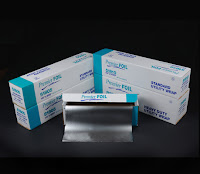High Density vs Low Density Trash Bags...does it matter?
 |
| Which liners do I need? |
To keep things simple, you may be buying just one or two liners thinking "one size fits all". However, you may actually be spending more money in the long run. Why? Depending on the location of your garbage bins, garbage itself can vary significantly in weight and size. For example, a trash liner used in restrooms contains for the most part paper towels or lightweight material. Therefore, a lighter gauge liner can be used verses a liner that may be used in a break room, kitchen, cafeteria or shop floor.
Where you throw things away as well as choosing the right size and gauge liner can save you money. To do this below are the pieces of information you will need to determine how you can choose the most cost effective way to purchase trash liners.
Choosing the right Density, Size, Weight & Color
Are you using the most cost-effective option? Let's see...
- Find out what your annual spend on trash liners.
- Find out what size trash bins you are using.
- Find out how many trash bins you use.
- Find out where your trash bins are located.
- Find out what kind of trash goes into each trash bin.
 |
| Low Density Trash Liners |
How To Choose The Right Density
What kind of garbage gets tossed in specific locations throughout your facility determines the right density. Will the bag need to contain sharp objects? Is the trash heavy or wet? If yes, you will need linear, low-density polyethylene bags.
Low Density Liners (LLD)
- Made of puncture and tear-resistant resin
- Great for waste that has sharp or jagged edges
- Great for heavy, wet or sharp objects
- Great for tough transport conditions
Low-Density Liners Key Characteristics
• Quiet when moved - No "crinkly" sound
• Easier to start or puncture a hole in than HD
• A hole will spread less quickly than HD
• Gauge (thickness) measured in MIL
• Most common type in the industry
Low-density trash liners are great for kitchens, construction areas or outdoor trash cans.
 |
| High Density Trash Liners |
- Best for soft refuse (office, restroom, paper)
- Great for cans without edges, paper, food, smooth heavy objects
- Three times stronger than ordinary polyethylene
- Lower-gauge resin, which is more temperature-resistant from -40 to 212 degrees
High-Density Liners (HD) Key Characteristics
- Makes 'crinkly' noise when you move it
- Harder to start or puncture a hole in than Low Density (LLD)
- Once a hole is started, will spread quickly or "zipper"
- Thinner than LLD, but can hold same or greater weight as LLD liners
- Gauge (thickness) measured in Micron (MIC)
- Substantial cost savings on a per-liner basis
The lighter construction of high-density bags can also help lower freight, storage and warehousing costs. So don't pay for the extra weight if you don't need it.
What's the Right Size?
If you are using more 'bag' than you need, you are wasting money. How do you know? Take a walk around your facility and look at how the bags fit each bin or can. If a bag hangs down over the edge of the can or receptacle by more than 4 inches, you are using too much bag for the job.
What About Weight?
A common misconception is weight or gauge. Many people believe that the heavier the gauge or thickness of the plastic, the better, or stronger the bag. Today this is not necessarily the case. The technology in plastic resins has really evolved, and thinner, lighter gauges with more flexibility now do the job of yesterday's heavier plastics.
How much weight does the bag need to hold? Figure out the average weight of a full can liner in its typical environment. Once you have decided on that weight, use that number to check the Maximum Load Rating of the bag. This number is available in any liner product listing.
Does Color Matter?
Opaque liners are best for aesthetic reasons and hide unsightly trash. This is important in hospitality environments where trash might need to be carried through common areas. Clear bags are often used for recycling and orange bags are often used along roadsides or somewhere visibility could potentially be an issue. For medical waste, bags that feature the bio-hazard symbol are essential.
Yes, choosing the right liners is a little work but is definitely worth the effort if you are interested in saving money.

























